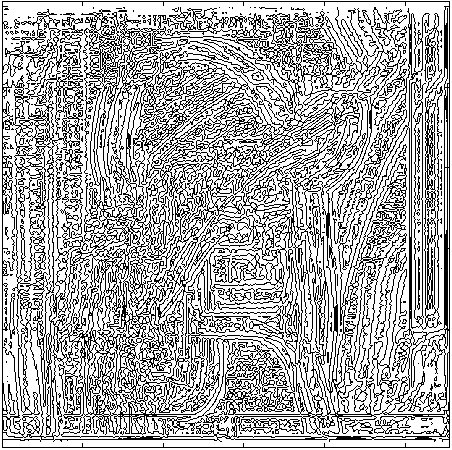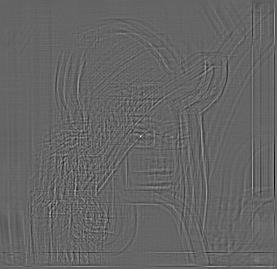Binary Matched Filtering with Pre-Processing
Techniques to Improve Matched Filtering
Binary Matched Filter with Pre-Processing
by Robert Sparr

Third Approach
We then decided to attempt further gains by pre-processing the image to remove coarse-scale variation in tone. We take one pass with the Mallat herringbone discrete wavelet transform algorithm using the Daubechies 7 wavelet and then take the sum of the LH, HH, and HL quadrants to obtain our new input. This process has the effect of emphasizing the image edges of all spatial orientations. (Note that we eschew decimation to retain the original image size.)



Figure 5. Sum of the LH, HH, and HL tiles and the result of the pre-processed image filtered with figure 3, contour plot and direct plot. Note small white spot at Lenna's right eye.
As you can see, the use of the DWT does indeed remove all but the highest-scale variation from the image; the only deviation from the mean occurs along image edges. Since the DWT considers high frequency variations along the diagonal as well as horizontal and vertical axes, image edges are highlighted largely independent of orientation.
As expected, the filtered version of the pre-processed image is also quite flat, with a narrow, high peak at Lenna's right eye. The pre-processing has eliminated the false secondary peaks noted in the previous two examples. (Note the small white spot on Lenna's right eye in the direct plot of the result. The same spot appears in the resultant images from the previous two examples, but the background variation makes the peak more difficult to detect, both visually and algorithmically.) Unfortunately, the use of the DWT also eliminated the secondary peak at Lenna's left eye.
We tested each of the approaches outlined here on a variety of images and found the behavior quite consistant from image to image. A binary matched filter designed to find a specific eye in an image does detect the eye but fails to detect the other. The use of the DWT pre-processing system described here does a good job of eliminating secondary peaks.

jchen@micro.ti.com
tdorney@ti.com
sparr@owlnet.rice.edu
Last updated on May 3, 1997
Copyright © 1997 All rights reserved.